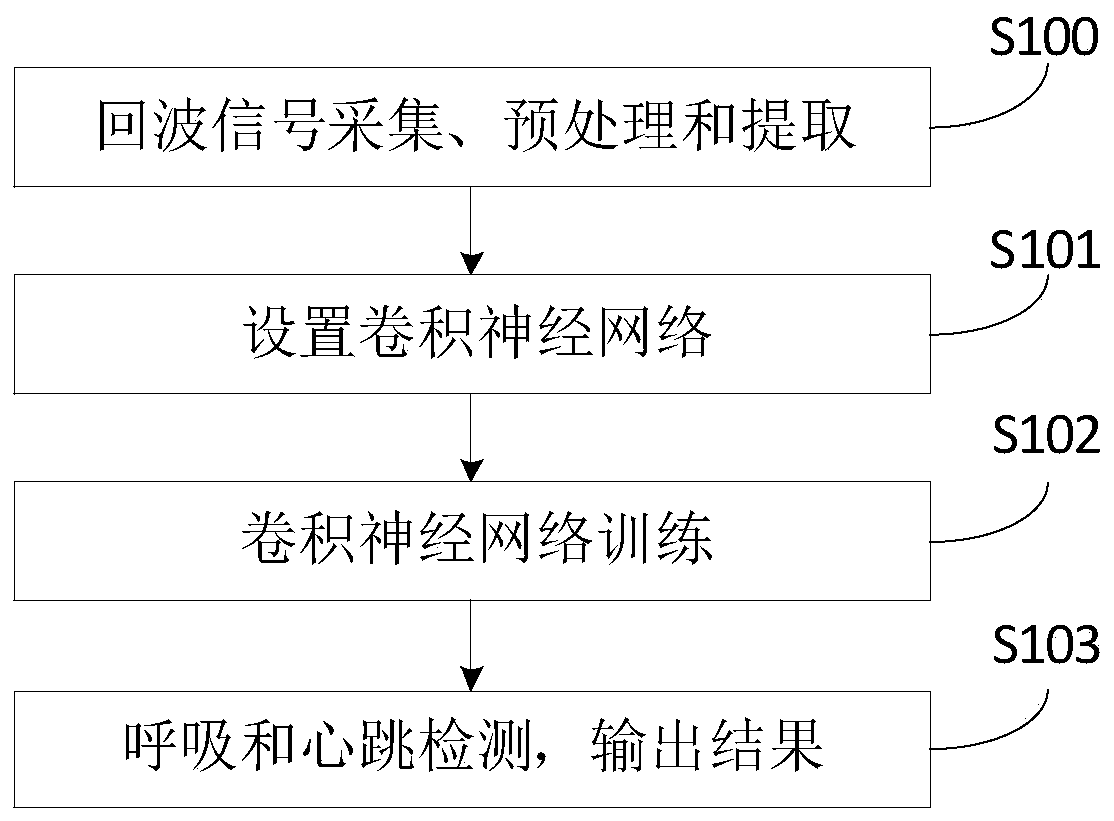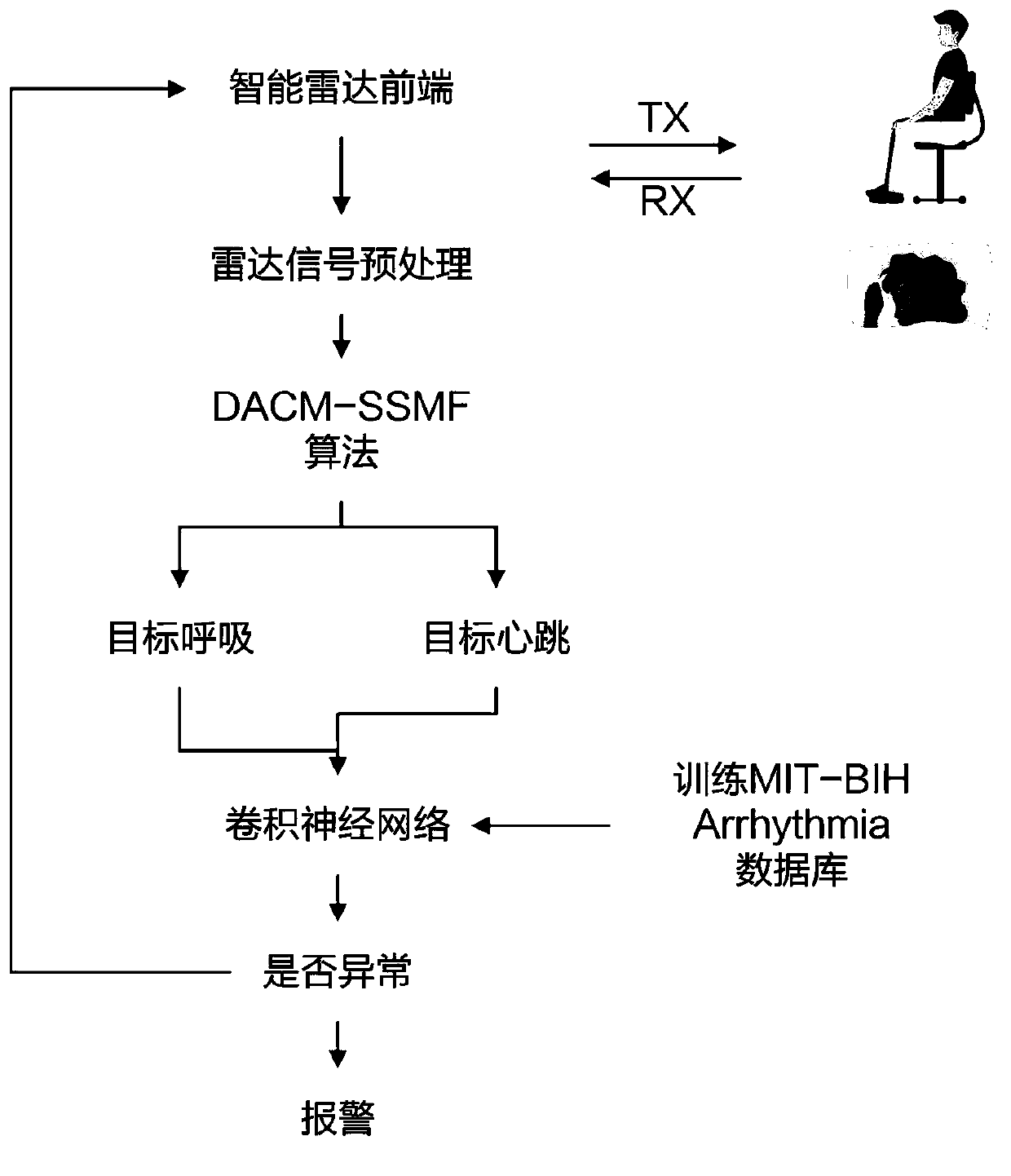Method and device of detecting human vital signs based on ultra-wideband radar
An ultra-wideband radar and vital sign technology, applied in the field of number detection, can solve the problems of inability to obtain accurate breathing and/or heartbeat values, deviation from the actual frequency, and reduced heartbeat resolution, so as to solve phase cross-border aliasing and eliminate slight movement. effects, effects of improving effects that cannot be extracted normally
- Summary
- Abstract
- Description
- Claims
- Application Information
AI Technical Summary
Problems solved by technology
Method used
Image
Examples
Embodiment 1
[0053] Embodiment 1 of the present invention provides a method for detecting human vital signs based on ultra-wideband radar, see figure 1 As shown, the method mainly includes the following steps:
[0054] Step S100, acquire the first echo signals of normal breathing and / or heartbeat of multiple human bodies and the second echo signals of abnormal breathing and / or heartbeat of multiple human bodies through ultra-wideband radar, and perform preprocessing and extraction, respectively Get normal detection sequence and abnormal detection sequence.
[0055] The normal and abnormal heartbeat and breathing of the present invention are all distinguished according to medical common sense. For example, the normal heart rate of ordinary adults (non-athletes) is 60 to 100 times per minute, while others are abnormal. Those skilled in the art The specific meanings of normal and abnormal in the present invention can be clarified based on common medical knowledge, and will not be repeated he...
Embodiment 2
[0061] Embodiment 2 of the present invention provides another embodiment of a method for detecting human vital signs based on ultra-wideband radar. In this embodiment, the detection method includes steps:
[0062] Step S200, initializing the radar and configuring radar parameters.
[0063] Step S201, acquiring normal breathing and / or heartbeat I / Q channel signals of the human body, and converting the first echo signal of the I / Q channel into a first complex signal.
[0064] In step S202, the phase of the first complex signal is obtained by applying Fourier transform in the fast time dimension, and the distance dimension component is eliminated.
[0065] Step S203, using DACM (extended differential and crossmultiply Method, extended differential and cross multiplication method) to solve the phase aliasing problem.
[0066] Step S204, performing z-transformation on the DACM-processed signal and using an accumulator to filter out zero-mean noise.
[0067] Step S205, using a med...
Embodiment 3
[0078] Embodiment 3 of the present invention provides a preferred embodiment of a method for detecting vital signs of a human body based on an ultra-wideband radar.
[0079] Specifically, as an implementable mode, the detection method in this embodiment includes steps:
[0080] Step S300, initialize the radar and configure radar parameters.
[0081] Step S301, acquiring the breathing and / or heartbeat radar echo signals of a normal or abnormal human body, and converting the echo signals of the I / Q channels in each frame into complex signals, the conversion formula is y(t,τ)=y I (t,τ)+jy Q (t,τ), j is the imaginary number unit, t is the interval of each frame, τ is the echo position in each frame, y(t,τ) is the complex signal, y I (t,τ) is the echo signal of channel I, y Q (t,τ) is the echo signal of the Q channel; further, the complex signal matrix can be expressed as N is the total number of echo signals.
[0082] Step S302, perform FFT (Fast Fourier Transformation, Fast...
PUM
 Login to View More
Login to View More Abstract
Description
Claims
Application Information
 Login to View More
Login to View More - R&D
- Intellectual Property
- Life Sciences
- Materials
- Tech Scout
- Unparalleled Data Quality
- Higher Quality Content
- 60% Fewer Hallucinations
Browse by: Latest US Patents, China's latest patents, Technical Efficacy Thesaurus, Application Domain, Technology Topic, Popular Technical Reports.
© 2025 PatSnap. All rights reserved.Legal|Privacy policy|Modern Slavery Act Transparency Statement|Sitemap|About US| Contact US: help@patsnap.com



